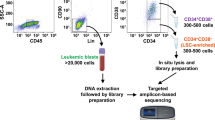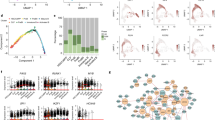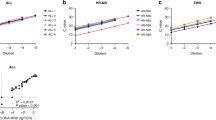Abstract
In acute myeloid leukaemia (AML), alterations in apoptotic pathways are crucial for treatment outcome, resulting either in refractoriness or in minimal residual disease (MRD). The apoptosis characteristics of MRD cells may differ from those at diagnosis and thereby determine the adequacy of further treatment. Such characteristics are largely unknown, since studies hereto are hampered by minimal cell availability. This study explores the applicability of the recently described RT-Multiplex Ligation-dependent Probe Amplification (RT-MLPA) for gene expression analysis of small amounts of RNA obtained from MRD cells. Reproducibility and dilution experiments showed that the relative expression of 37 apoptosis-related genes starting with only 1000 cells could be measured with 12% variation; for 100 cells, 31/37 genes could still be quantified, though expression variation increased. In practice 100–1000 leukemic cells can be obtained from bone marrow samples with clinically relevant MRD percentages of 0.01–0.1. Procedures often necessary to obtain AML blasts, that is, FACS-sorting, freeze-thawing or combinations are possible, provided that selected viable nonapoptotic cells are used. Concluding, RT-MLPA allows accurate gene expression profiling of MRD cells. This method will help to gain insight into the processes of MRD emergence and persistence in AML, which may ultimately guide new therapeutic strategies in AML.
This is a preview of subscription content, access via your institution
Access options
Subscribe to this journal
Receive 12 print issues and online access
$259.00 per year
only $21.58 per issue
Buy this article
- Purchase on Springer Link
- Instant access to full article PDF
Prices may be subject to local taxes which are calculated during checkout




Similar content being viewed by others
References
Burnett AK, Goldstone AH, Stevens RM, Hann IM, Rees JK, Gray RG et al. Randomised comparison of addition of autologous bone-marrow transplantation to intensive chemotherapy for acute myeloid leukaemia in first remission: results of MRC AML 10 trial. UK Medical Research Council Adult and Children's Leukaemia Working Parties. Lancet 1998; 351: 700–708.
Campana D, Coustan-Smith E . Detection of minimal residual disease in acute leukemia by flow cytometry. Cytometry 1999; 38: 139–152.
Orfao A, Schmitz G, Brando B, Ruiz-Arguelles A, Basso G, Braylan R et al. Clinically useful information provided by the flow cytometric immunophenotyping of hematological malignancies: current status and future directions. Clin Chem 1999; 45: 1708–1717.
San Miguel JF, Ciudad J, Vidriales MB, Orfao A, Lucio P, Porwit-MacDonald A et al. Immunophenotypical detection of minimal residual disease in acute leukemia. Crit Rev Oncol Hematol 1999; 32: 175–185.
van der Pol MA, Pater JM, Feller N, Westra AH, van Stijn A, Ossenkoppele GJ et al. Functional characterization of minimal residual disease for P-glycoprotein and multidrug resistance protein activity in acute myeloid leukemia. Leukemia 2001; 15: 1554–1563.
Venditti A, Tamburini A, Buccisano F, Del Poeta G, Maurillo L, Panetta P et al. Clinical relevance of minimal residual disease detection in adult acute myeloid leukemia. J Hematother Stem Cell Res 2002; 11: 349–357.
Venditti A, Maurillo L, Buccisano F, Del Poeta G, Mazzone C, Tamburini A et al. Pretransplant minimal residual disease level predicts clinical outcome in patients with acute myeloid leukemia receiving high-dose chemotherapy and autologous stem cell transplantation. Leukemia 2003; 17: 2178–2182.
Feller N, van der Pol MA, van Stijn A, Weijers G, Westra AH, Evertse BW et al. MRD parameters using immunophenotypic detection methods are highly reliable in predicting survival in acute myeloid leukemia. Leukemia 2004; 18: 1380–1390.
van Stijn A, Kok A, van der Pol MA, Feller N, Roemen GM, Westra AH et al. A flow cytometric method to detect apoptosis-related protein expression in minimal residual disease in acute myeloid leukemia. Leukemia 2003; 17: 780–786.
van Stijn A, Kok A, van Stalborch MA, Der Pol MA, Feller N, Westra AH et al. Minimal residual disease cells in AML patients have an apoptosis-sensitive protein profile. Leukemia 2004; 18: 875–877.
Schouten JP, McElgunn CJ, Waaijer R, Zwijnenburg D, Diepvens F, Pals G . Relative quantification of 40 nucleic acid sequences by multiplex ligation-dependent probe amplification. Nucleic Acids Res 2002; 30: e57.
Eldering E, Spek CA, Aberson HL, Grummels A, Derks IA, de Vos AF et al. Expression profiling via novel multiplex assay allows rapid assessment of gene regulation in defined signalling pathways. Nucleic Acids Res 2003; 31: e153.
Feller N, Schuurhuis GJ, van der Pol MA, Westra G, Weijers GW, van Stijn A et al. High percentage of CD34-positive cells in autologous AML peripheral blood stem cell products reflects inadequate in vivo purging and low chemotherapeutic toxicity in a subgroup of patients with poor clinical outcome. Leukemia 2003; 17: 68–75.
Spek CA, Verbon A, Aberson H, Pribble JP, McElgunn CJ, Turner T et al. Treatment with an anti-CD14 monoclonal antibody delays and inhibits lipopolysaccharide-induced gene expression in humans in vivo. J Clin Immunol 2003; 23: 132–140.
Bustin SA . Absolute quantification of mRNA using real-time reverse transcription polymerase chain reaction assays. J Mol Endocrinol 2000; 25: 169–193.
Pallisgaard N, Clausen N, Schroder H, Hokland P . Rapid and sensitive minimal residual disease detection in acute leukemia by quantitative real-time RT-PCR exemplified by t(12;21) TEL-AML1 fusion transcript. Genes Chromosomes Cancer 1999; 26: 355–365.
Degan M, Mazzocco FT, Di Francia R, Rossi FM, Pinto A, Gattei V . Normalizing complementary DNA by quantitative reverse transcriptase-polymerase chain reaction of beta2-microglobulin: molecular monitoring of minimal residual disease in acute promyelocytic leukemia. Diagn Mol Pathol 2000; 9: 98–109.
Radich JP, Gooley T, Bryant E, Chauncey T, Clift R, Beppu L et al. The significance of bcr-abl molecular detection in chronic myeloid leukemia patients ‘late,’ 18 months or more after transplantation. Blood 2001; 98: 1701–1707.
Gabert J, Beillard E, Van Der Velden VH, Bi W, Grimwade D, Pallisgaard N et al. Standardization and quality control studies of ‘real-time’ quantitative reverse transcriptase polymerase chain reaction of fusion gene transcripts for residual disease detection in leukemia – a Europe Against Cancer program. Leukemia 2003; 17: 2318–2357.
Tamaki H, Mishima M, Kawakami M, Tsuboi A, Kim EH, Hosen N et al. Monitoring minimal residual disease in leukemia using real-time quantitative polymerase chain reaction for Wilms tumor gene (WT1). Int J Hematol 2003; 78: 349–356.
Beillard E, Pallisgaard N, Van Der Velden VH, Bi W, Dee R, Van Der Schoot E et al. Evaluation of candidate control genes for diagnosis and residual disease detection in leukemic patients using ‘real-time’ quantitative reverse-transcriptase polymerase chain reaction (RQ-PCR) – a Europe against cancer program. Leukemia 2003; 17: 2474–2486.
Miller RA, Galecki A, Shmookler-Reis RJ . Interpretation, design, and analysis of gene array expression experiments. J Gerontol A Biol Sci Med Sci 2001; 56: B52–B57.
Lacombe F, Durrieu F, Briais A, Dumain P, Belloc F, Bascans E et al. Flow cytometry CD45 gating for immunophenotyping of acute myeloid leukemia. Leukemia 1997; 11: 1878–1886.
Vermes I, Haanen C, Reutelingsperger C . Flow cytometry of apoptotic cell death. J Immunol Methods 2000; 243: 167–190.
Breit S, Nees M, Schaefer U, Pfoersich M, Hagemeier C, Muckenthaler M et al. Impact of pre-analytical handling on bone marrow mRNA gene expression. Br J Haematol 2004; 126: 231–243.
Tanner MA, Berk LS, Felten DL, Blidy AD, Bit SL, Ruff DW . Substantial changes in gene expression level due to the storage temperature and storage duration of human whole blood. Clin Lab Haematol 2002; 24: 337–341.
Almeida A, Paul TJ, Magdelenat H, Radvanyi F . Gene expression analysis by real-time reverse transcription polymerase chain reaction: influence of tissue handling. Anal Biochem 2004; 328: 101–108.
Kern W, Danhauser-Riedl S, Ratei R, Schnittger S, Schoch C, Kolb HJ et al. Detection of minimal residual disease in unselected patients with acute myeloid leukemia using multiparameter flow cytometry for definition of leukemia-associated immunophenotypes and determination of their frequencies in normal bone marrow. Haematologica 2003; 88: 646–653.
Venditti A, Buccisano F, Del Poeta G, Maurillo L, Tamburini A, Cox C et al. Level of minimal residual disease after consolidation therapy predicts outcome in acute myeloid leukemia. Blood 2000; 96: 3948–3952.
San Miguel JF, Martinez A, Macedo A, Vidriales MB, Lopez-Berges C, Gonzalez M et al. Immunophenotyping investigation of minimal residual disease is a useful approach for predicting relapse in acute myeloid leukemia patients. Blood 1997; 90: 2465–2470.
Acknowledgements
We are indebted to Dr J Berkhof for statistical assistance.
Author information
Authors and Affiliations
Corresponding author
Rights and permissions
About this article
Cite this article
Hess, C., Denkers, F., Ossenkoppele, G. et al. Gene expression profiling of minimal residual disease in acute myeloid leukaemia by novel multiplex-PCR-based method. Leukemia 18, 1981–1988 (2004). https://doi.org/10.1038/sj.leu.2403520
Received:
Accepted:
Published:
Issue Date:
DOI: https://doi.org/10.1038/sj.leu.2403520
Keywords
This article is cited by
-
Copy Number Variation in CCND1 Gene Is Implicated in the Pathogenesis of Sporadic Parathyroid Carcinoma
World Journal of Surgery (2014)
-
Rapid screening of innate immune gene expression in zebrafish using reverse transcription - multiplex ligation-dependent probe amplification
BMC Research Notes (2011)
-
Environment-mediated drug resistance: a major contributor to minimal residual disease
Nature Reviews Cancer (2009)
-
Aberrant marker expression patterns on the CD34+CD38− stem cell compartment in acute myeloid leukemia allows to distinguish the malignant from the normal stem cell compartment both at diagnosis and in remission
Leukemia (2007)



